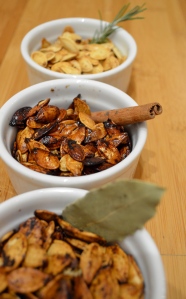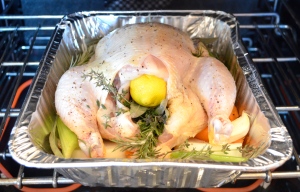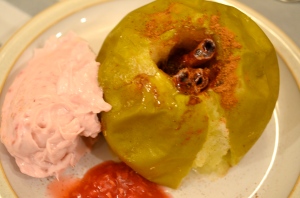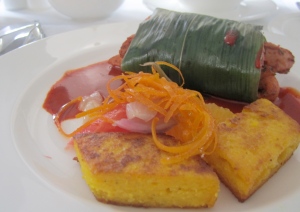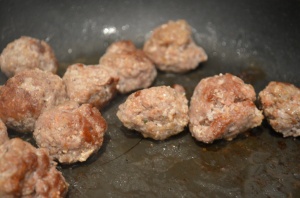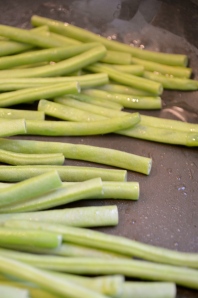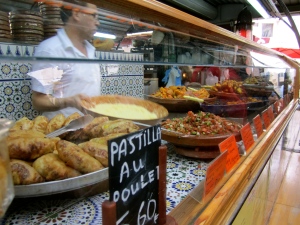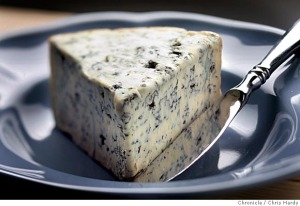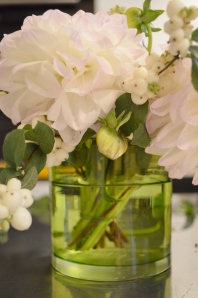In part 1 of A Table for Two, I mentioned a few suggestions about where to grab lunch in Paris. But if you’re really looking for a true Parisian dining experience, save yourself for dinner. For at dinner you can take your time, drink a bottle of wine, sit, relax and chat without worries of getting to the Louvre before it closes.
First thing to know is that the French eat late. It’s rare to see a brasserie get busy before 8pm, with some not even opening their doors until that time. Even if you’re looking for a delicious gourmet meal with a nice bottle of wine at 11pm, most restaurants in Paris will be able to provide that for you, even if it’s a Tuesday night. This is quite refreshing coming from sleepy old Vitoria BC, where almost everything shuts down at 10pm at the latest, and usually your only option to pacify your late-night grumbling tummy is with greasy pizza or the consistently questionable Pita Pit.
So, here are some of my favourite dinner spots in Paris…
La Mascotte:
*52 Rue des Abbesses, 75018 Paris. 01 46 06 28 15
*la-mascotte-montmartre.com
Amongst many other things, the hillside district of Montmartre is known for its hip residents, cool café’s, and trendy bohemian hotspots. This is why La Mascotte, with its traditional menu and old aesthetic, is a lovely surprise. They’re known for their fresh seafood, but locals also pack the restaurant to taste more warming options of stews and roasts. While making our way to dinner from a trip to the Sacré-Cœur Basilica, my friend and I were caught in a torrential downpour. As we ran to the restaurant, newspaper-umbrellas over our heads, the front opening of La Mascotte was as if a divine beacon of light on the busy Rus d’Abbesse.

Montmartre

Inside Sacré-Cœur Basilica

View of Paris from Sacré-Cœur
Probably feeling slightly chilled and a little sorry for herself, my friend went for the more comfort-food side of things with a bean and beef stew. I decided to see how good their seafood really was, and chose a slightly more finicky dish of prawns, salmon and a hearty ratatouille.

 Satisfied and now dry, we left the restaurant only to find the skies had cleared and the sparkling Montmartre scene living up to its nightlife hype.
Satisfied and now dry, we left the restaurant only to find the skies had cleared and the sparkling Montmartre scene living up to its nightlife hype.
Tapas Nocturnes:
*98 Rue Martyrs, 75018 Paris. 01 42 62 43 94
*tapasnocturnes.com
Although a walk around Sacré-Cœur and dinner at La Mascotte was a great first introduction to Montmarte, I had to go back for more. On my second visit to this fascinating jewel of Paris, I had a slightly less traditional French meal, and a slightly more outrageous French tourist experience.
Dinner was at Tapas Nocturnes where my friend and I enjoyed an amazing assortment of Spanish tasting-plates including marinated anchovies, cod croquettes, eggplant cooked with basil and tomato, potatoes in bravas sauce, a mixed green salad with shaved asiago cheese, and a vegetarian frittata.




 For dessert, we shared a gorgeous Petits Meolleux Chauds au Chocolat served with icecream, whipped cream and raspberry coulis.
For dessert, we shared a gorgeous Petits Meolleux Chauds au Chocolat served with icecream, whipped cream and raspberry coulis.
 Our post dinner activity was none other than the infamous Moulin Rouge burlesque show – exactly what I was hoping it would be, and a definite must if you’re ever in Paris.
Our post dinner activity was none other than the infamous Moulin Rouge burlesque show – exactly what I was hoping it would be, and a definite must if you’re ever in Paris.
 Le Troquet:
Le Troquet:
*21, Rue Francois Bonvin, 75015 Paris. 01 45 66 89 00
But sometimes you don’t have to take a 30-minute metro ride to the other side of town to have a perfect dining experience. No, sometimes you’re lucky enough to have an acclaimed French bistro just down your block, and my neighborhood gem was the highly regarded Le Troquet. Like Café Constant in part one of this post, here you can do a fixed menu, where only 30 Euros will get you a starter, a main and a dessert. Or if you’re feeling a tad more daring and a lot hungrier, try their 5-course taster menu for only 42 Euros. My friend and I weren’t feeling like we could take on 5 courses, so we opted for the slightly more subdued, but still extremely satisfying three-course meal option.
 For our starters we chose a salmon tartare served on thinly sliced radish, and a poached egg dish placed on a juicy bed of a teeny little chanterelle mushroom mix. For our mains, we both chose fish, one of which was pan-fried sea bream served on top of a creamy zucchini purée. I ordered an absolutely amazing sea bass dish accompanied by a wonderful mashed cauliflower side, but unfortunately I was too busy scarfing it down to take a picture. Guess you’ll just have to go there and order it (or something like it as they change their menu constantly) to see for yourself.
For our starters we chose a salmon tartare served on thinly sliced radish, and a poached egg dish placed on a juicy bed of a teeny little chanterelle mushroom mix. For our mains, we both chose fish, one of which was pan-fried sea bream served on top of a creamy zucchini purée. I ordered an absolutely amazing sea bass dish accompanied by a wonderful mashed cauliflower side, but unfortunately I was too busy scarfing it down to take a picture. Guess you’ll just have to go there and order it (or something like it as they change their menu constantly) to see for yourself.


 For dessert we enjoyed a sampling of a stiff goats cheese served with homemade cherry jam, and a stunning poached pear dish placed artistically in a pool of rich chocolate and slightly melted icecream.
For dessert we enjoyed a sampling of a stiff goats cheese served with homemade cherry jam, and a stunning poached pear dish placed artistically in a pool of rich chocolate and slightly melted icecream.

 The decor was delightfully cozy, the staff were unbelievably friendly, and my only regret is that I didn’t go back there numerous times before I left to sample everything on their enticing menu.
The decor was delightfully cozy, the staff were unbelievably friendly, and my only regret is that I didn’t go back there numerous times before I left to sample everything on their enticing menu.


L’Epigramme:
*9 Rue de l’Éperon, 75006 Paris. 01 44 41 00 09
Although this next restaurant wasn’t two doors down from me, it was still pretty close in the nearby neighborhood of St Germain de Près, and was also hidden away on some unassuming and poorly lit side street. If it weren’t for the amazing review in my travel book and my unwavering determination to find our destination, we would have never stumbled upon this little hole-in-the-wall, for that was truly what it was. If you look down Rue de l’Éperon you will see nothing. Walk a little further and you’ll start to hear the hum of dinner conversation and a glow coming from a few small steamed up windows. We arrived somewhat saddened to see that every table was full, but thankfully the friendly staff were more than willing to accommodate us, and set up a little place for two right by the kitchen.
Also a prix fixe menu, my friend and I went for the 3-course option and enjoyed a beautifully prepared escargot starter served in a flavourful cream sauce, as well as fois gras accompanied by a sweet and sour apricot chutney.

 For our mains, we enjoyed two fish dishes yet again, one being a perfectly seasoned cod served with creatively prepared potato fritters, as well as sea bass placed upon grilled asparagus and accompanied by a light and frothy citrus cream sauce.
For our mains, we enjoyed two fish dishes yet again, one being a perfectly seasoned cod served with creatively prepared potato fritters, as well as sea bass placed upon grilled asparagus and accompanied by a light and frothy citrus cream sauce.

 Dessert was banana-coconut crème brûlé, and yet another poached pear dish, this time served with a crunchy toffee tutu, sitting in a pool of nutty caramel sauce.
Dessert was banana-coconut crème brûlé, and yet another poached pear dish, this time served with a crunchy toffee tutu, sitting in a pool of nutty caramel sauce.

 Before enjoying this magnificent and modestly-priced meal, my friend and I had a very cultured evening at the Musée D’Orsay and a celebrity sighting of fashion king Karl Lagerfeld, so we were feeling rather pleased with ourselves as we licked our plates clean and finished off our last drops of rosé.
Before enjoying this magnificent and modestly-priced meal, my friend and I had a very cultured evening at the Musée D’Orsay and a celebrity sighting of fashion king Karl Lagerfeld, so we were feeling rather pleased with ourselves as we licked our plates clean and finished off our last drops of rosé.
L’Ecailler Du Bistrot:
*22 Rue Paul Bert, 75011 Paris. 01 43 72 76 77
If you’re looking for a real Parisian seafood experience, check out this well acclaimed restaurant in the hip 11ème arrondissement, but it’s probably a good idea to bring someone along with you who actually knows what they’re doing. If it weren’t for my gastronomically experienced Parisian friend Julia, I don’t think I would have been able to eat a single thing on the ridiculous platter for “three,” although I’m pretty sure it’s better suited for an army of ravenous men. That being said, I don’t think I would have ever even ordered a platter like this on my own accord, but my Parisian friend insisted, and off we went for this labour intensive feast.
 The dessert was somewhat of a reward for all of our hard work, as we effortlessly enjoyed a cream and raspberry filled macaron, and some poached figs served with icecream.
The dessert was somewhat of a reward for all of our hard work, as we effortlessly enjoyed a cream and raspberry filled macaron, and some poached figs served with icecream.

 The food was unbelievably fresh, but I couldn’t help notice the prepared dishes arriving at the adjacent tables that seemed to take much less exertion to enjoy. So if you’re planning on going and want an authentic Parisian seafood experience, get the platter. But if dozens of strange utensils and the idea of not-quite-dead-yet oysters that wriggle when you squirt lemon on them terrify you, go for one of their beautifully prepared single-serving plates instead.
The food was unbelievably fresh, but I couldn’t help notice the prepared dishes arriving at the adjacent tables that seemed to take much less exertion to enjoy. So if you’re planning on going and want an authentic Parisian seafood experience, get the platter. But if dozens of strange utensils and the idea of not-quite-dead-yet oysters that wriggle when you squirt lemon on them terrify you, go for one of their beautifully prepared single-serving plates instead.

Frenchie:
*5 rue du Nil, 75002 Paris. 01 40 39 96 19
*frenchie-restaurant.com
Aaahh Frenchie… Not only did it take my friend and I over an hour of running around the winding streets of Paris to find you, but once we did, you weren’t open. I mean it was only a Saturday night, when every other restaurant in Paris was packed and bustling. Ooohhh and Frenchie, you rubbed salt on our wounds when we came to you a second time and the waitress told us they only take reservations at least two months in advance. Good thing we were hungry and persistent, and decided to stick around in case someone didn’t show up for their long awaited rezo, because once 7:30 rolled around, we were given a delightful corner table right beside a group of obnoxious American trust-fund babies who had too many bottles of wine, and were not afraid to scream at the top of their lungs how privileged and pretentious they were in this insanely intimate little bistro. Truly it was right out of a scene from American Psycho, minus the whole bloody chainsaw bit. But aside from the strange opening times, impossible-to-find location and gag-inducing neighbouring table, our dining experience truly lived up to its much hyped reputation.
 The brainchild of esteemed chefs Jamie Oliver and Gregory Marchand, Frenchie is both underground and mainstream with its immaculate adherence to the ways of traditional French bistro dining, and tables full of food journalists and critics from around the world. The front-of-house staff were wonderfully friendly, and I can only assume the back-of-house employees are all culinary genius’s to pull off each dish with such innovation and panache. A small prix fixe menu, our minds were already made up for us, as there were only two options per course. To start, we had sweetbread nuggets with girolle mushrooms and celery, as well as a smoked trout dish with pickled onion vinaigrette. For our mains we each sampled bites from line caught silver hake served with tomatoes and Béarn beans in broth, as well as a tender lamb dish with puréed cauliflower and summer truffle.
The brainchild of esteemed chefs Jamie Oliver and Gregory Marchand, Frenchie is both underground and mainstream with its immaculate adherence to the ways of traditional French bistro dining, and tables full of food journalists and critics from around the world. The front-of-house staff were wonderfully friendly, and I can only assume the back-of-house employees are all culinary genius’s to pull off each dish with such innovation and panache. A small prix fixe menu, our minds were already made up for us, as there were only two options per course. To start, we had sweetbread nuggets with girolle mushrooms and celery, as well as a smoked trout dish with pickled onion vinaigrette. For our mains we each sampled bites from line caught silver hake served with tomatoes and Béarn beans in broth, as well as a tender lamb dish with puréed cauliflower and summer truffle.



 Dessert was equally impressive with a lemon tart accompanied by a passion fruit salty caramel butter, as well as coconut Japanese pearls mixed with strawberries and avocado.
Dessert was equally impressive with a lemon tart accompanied by a passion fruit salty caramel butter, as well as coconut Japanese pearls mixed with strawberries and avocado.

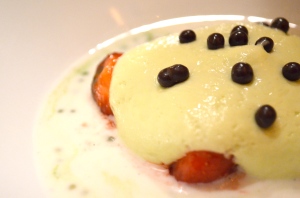 To accompany all these amazing plates, we nibbled on some freshly made country bread, and sampled both an amazing white and red wine, each at the brilliant recommendation of our server.
To accompany all these amazing plates, we nibbled on some freshly made country bread, and sampled both an amazing white and red wine, each at the brilliant recommendation of our server.


 So if you are planning on going to Frenchie (which I would highly recommend – it was one of my best culinary experiences to date for an impossibly low price), make reservations well in advance and bring earplugs in case you too get stuck next to vocally liberal and casually cussing snobs from New York.
So if you are planning on going to Frenchie (which I would highly recommend – it was one of my best culinary experiences to date for an impossibly low price), make reservations well in advance and bring earplugs in case you too get stuck next to vocally liberal and casually cussing snobs from New York.
 Halloween is one of my favourite holidays. Whether you get a kick out of the crazy costumes and parties, or are more a fan of the spooky occult-themed activities, it’s a great time of the year for fun with friends and family.
Halloween is one of my favourite holidays. Whether you get a kick out of the crazy costumes and parties, or are more a fan of the spooky occult-themed activities, it’s a great time of the year for fun with friends and family. Another fun activity to do a few days before Halloween is to grab a pair of your favourite wellies and visit the local pumpkin patch. Here you can enjoy the crisp fall air and open spaces while you choose your jack-o-lantern-to-be, as opposed to hard-to-reach boxes that are soggily stacked high with picked-over rejects at the grocery store.
Another fun activity to do a few days before Halloween is to grab a pair of your favourite wellies and visit the local pumpkin patch. Here you can enjoy the crisp fall air and open spaces while you choose your jack-o-lantern-to-be, as opposed to hard-to-reach boxes that are soggily stacked high with picked-over rejects at the grocery store. This year I decided to make three different types of roasted pumpkin seeds, as well as a creamy pumpkin soup inspired by a recipe a friend of mine passed along to me.
This year I decided to make three different types of roasted pumpkin seeds, as well as a creamy pumpkin soup inspired by a recipe a friend of mine passed along to me. I baked them all on parchment-paper covered cookie sheets at 350 for about 30 minutes. Make sure you’re watching and turning the seeds throughout, as some toppings cause them to bake a bit faster (for this batch I found the sweet ones were the quicker cookers). These little vitamin-packed treats also make lovely autumnal gifts, although recipients should be warned of their addictive nature.
I baked them all on parchment-paper covered cookie sheets at 350 for about 30 minutes. Make sure you’re watching and turning the seeds throughout, as some toppings cause them to bake a bit faster (for this batch I found the sweet ones were the quicker cookers). These little vitamin-packed treats also make lovely autumnal gifts, although recipients should be warned of their addictive nature. The soup is a rather loose recipe, with little guidance and practically non-existent quantities. Really the exercise here is to taste constantly and go with your intuition. I began by softening the pumpkin innards in a slow-cooker for about 4-5 hours. If you’re not using the bulk of the meat for your jack-o-lantern, another method is to roast the insides like you would with squash, until it’s soft and somewhat caramelized.
The soup is a rather loose recipe, with little guidance and practically non-existent quantities. Really the exercise here is to taste constantly and go with your intuition. I began by softening the pumpkin innards in a slow-cooker for about 4-5 hours. If you’re not using the bulk of the meat for your jack-o-lantern, another method is to roast the insides like you would with squash, until it’s soft and somewhat caramelized. Once the pulp was malleable, I ladled it into a food processor and mixed it on high until it formed a smoother but still moist paste. I then added some applesauce, and a splash of coconut milk, and mixed it again until the ingredients were well combined. To flavour the soup I added a combination of curry, chilli and garlic powder, as well as a couple tablespoons of maple syrup, a splash of vegetable stock, wine and balsamic vinegar, a dash of Worcestershire sauce, and of course generous amounts of salt and pepper to taste. Really the whole recipe is “to taste,” so make sure you have plenty of people in the room to sample as you go if you don’t trust your own palate.
Once the pulp was malleable, I ladled it into a food processor and mixed it on high until it formed a smoother but still moist paste. I then added some applesauce, and a splash of coconut milk, and mixed it again until the ingredients were well combined. To flavour the soup I added a combination of curry, chilli and garlic powder, as well as a couple tablespoons of maple syrup, a splash of vegetable stock, wine and balsamic vinegar, a dash of Worcestershire sauce, and of course generous amounts of salt and pepper to taste. Really the whole recipe is “to taste,” so make sure you have plenty of people in the room to sample as you go if you don’t trust your own palate. So even though all hallow’s eve has almost come to an end for 2011, you now have an ample 365 days to plan for next year’s festivities with a few added suggestions to help. In the meantime, here are a some rather unexpected Halloween themed songs (including your much anticipated Smashing Pumpkins promise) to inspire you as you do all your carving and cooking. But I warn you…some might be a tad “frightening” to the more conservative crowds. Happy Halloween!
So even though all hallow’s eve has almost come to an end for 2011, you now have an ample 365 days to plan for next year’s festivities with a few added suggestions to help. In the meantime, here are a some rather unexpected Halloween themed songs (including your much anticipated Smashing Pumpkins promise) to inspire you as you do all your carving and cooking. But I warn you…some might be a tad “frightening” to the more conservative crowds. Happy Halloween!





